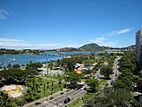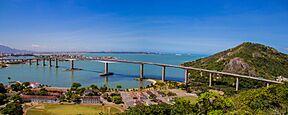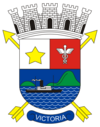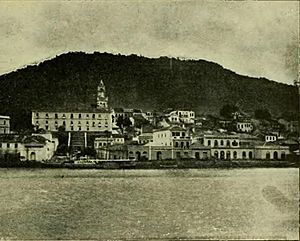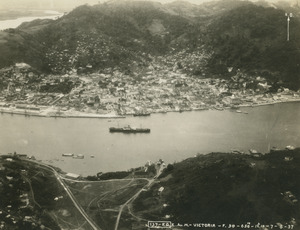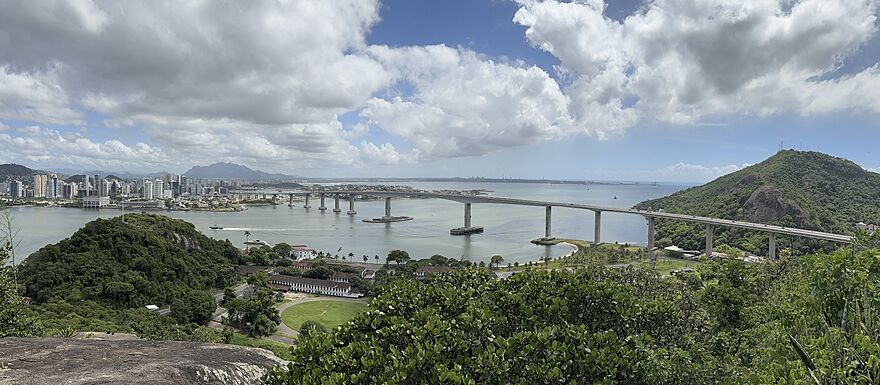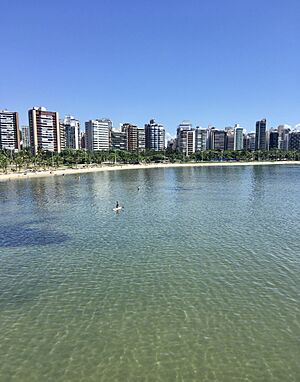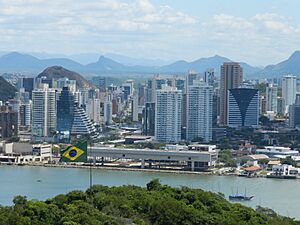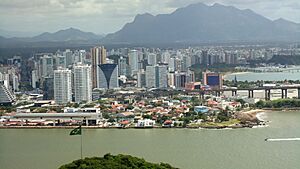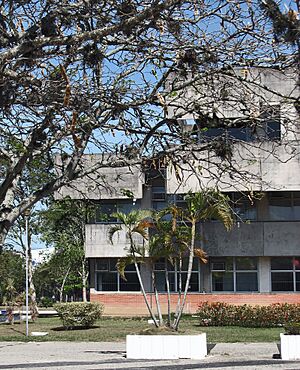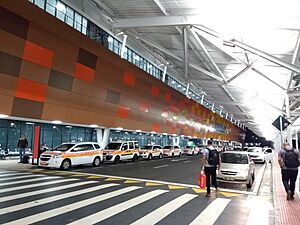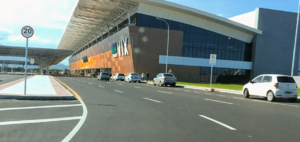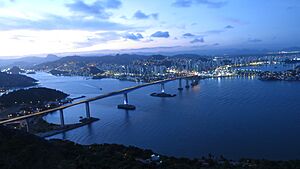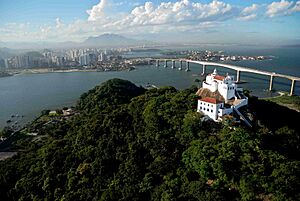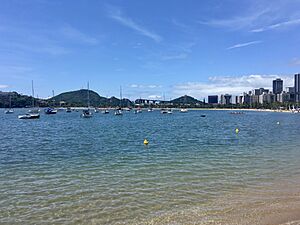Vitória, Espírito Santo facts for kids
Quick facts for kids
Vitória
|
|||
|---|---|---|---|
|
Municipality
|
|||
| Municipality of Vitória | |||
|
Skyline from the Penha Convent
Praça dos Namorados and Ilha do Boi
Anchieta Palace
Carlos Gomes Theater
Third Bridge crossing Vitória Bay
|
|||
|
|||
| Nickname(s):
Ilha do Mel
Cidade Ensolarada Vix |
|||
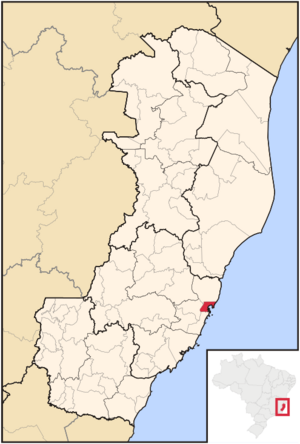
Location in Espírito Santo
|
|||
| Country | |||
| Region | Southeast | ||
| State | |||
| Founded | 8 September 1551 | ||
| Area | |||
| • Municipality | 93.381 km2 (36.055 sq mi) | ||
| • Metro | 3,204.26 km2 (1,237.17 sq mi) | ||
| Elevation | 4 m (13 ft) | ||
| Population
(2022 estimate)
|
|||
| • Municipality | 322,869 | ||
| • Density | 3,324.33/km2 (8,610.0/sq mi) | ||
| • Metro | 1,880,828 | ||
| Demonym(s) | vitoriense | ||
| GDP (PPP, constant 2015 values) | |||
| • Year | 2023 | ||
| • Total | $32.6 billion | ||
| Time zone | UTC-3 (BRT) | ||
| Postal code |
29000-001 to 29099-999
|
||
| Area code | +55 27 | ||
| HDI (2010) | 0.845 – very high | ||
| Major airport | Vitória International Airport | ||
| Federal Highways | |||
Vitória (which means "Victory") is the capital city of the Espírito Santo state in Brazil. It is located on a small island inside a bay where several rivers meet the sea. The city was founded in 1551.
Vitória proper covers about 93 square kilometers (36 square miles). In 2022, its population was 322,869 people. The larger Greater Vitória area, which includes nearby cities, has over 1.8 million people. This makes it the 14th largest metropolitan area in Brazil.
Vitória is a river island surrounded by Vitória Bay. Besides the main island, 34 other islands and a small part of the mainland are also part of the city. Originally, there were 50 islands, but many were connected to the main island by filling in land.
In 1998, the United Nations said Vitória was the fourth best state capital in Brazil to live in. They looked at things like health, education, and social projects. Vitória also has the second best human development index (HDI) among Brazilian capitals, after Florianópolis. In 2013, the United Nations ranked it as the fourth best Brazilian city overall to live in. It also had the highest GDP per person in Brazil.
The city has two big ports: the Port of Vitória and the Port of Tubarão. These ports are part of the largest port system in Brazil and are known for their high quality. Vitória is on the coast, close to the mountains of Espírito Santo. The city also manages the Trindade and Martim Vaz islands, which are about 1,100 kilometers (680 miles) off the coast. These islands are important for weather forecasting because of their location.
Contents
Exploring Vitória's Location
Vitória is a city on the southeastern coast of Brazil. It is the capital of the Espírito Santo state. The city is quite small, covering about 97 square kilometers (37 square miles). It is one of the smallest cities in the state and the smallest among Brazil's 27 state capitals.
The city is located in Vitória Bay. It is divided into a mainland part and the island of Vitória. To the east, Vitória faces the Atlantic Ocean. It shares borders with three other cities: Serra to the north, Cariacica to the west, and Vila Velha to the south. Together with these cities and Fundão, Guarapari, and Viana, they form the Metropolitan Region of Vitória, also known as Greater Vitória.
Vitória is part of the coastal plain. Its land is made up of hills and flat areas. The city is also part of the Atlantic Forest, a large forest that runs along Brazil's eastern coast. This area has tropical forests, mangroves, sandbanks, and dune plants.
Two rivers, the Santa Maria da Vitória and Jucu rivers, provide water for the Greater Vitória area. The city's beaches include Camburi, Curva da Jurema, and Castanheiras. Vitória has 80 neighborhoods, which are grouped into nine main areas:
- Centro
- Santo Antônio
- Jucutuquara
- Maruípe
- Praia do Canto
- Continental
- São Pedro
- Jardim Camburi
- Jardim da Penha
Vitória's Landscape and Islands
The islands around Vitória are like an extension of the mainland. They are made of granite and surrounded by the sea. They have native Brazilian restinga (coastal forest) and mangrove plants.
The highest point on Vitória Island is Morro da Fonte Grande, which is 308.8 meters (1,013 feet) tall. Other important granite hills are Pedra dos Dois Olhos (296 meters) and Morro de São Benedito (194 meters). Vitória's highest point overall is Pico do Desejado, located on Trindade Island, which is 601 meters (1,972 feet) high. This island is about 1,100 kilometers (680 miles) away from the mainland coast.
Vitória's Climate and Weather
| Weather chart for Vitória | |||||||||||||||||||||||||||||||||||||||||||||||
|---|---|---|---|---|---|---|---|---|---|---|---|---|---|---|---|---|---|---|---|---|---|---|---|---|---|---|---|---|---|---|---|---|---|---|---|---|---|---|---|---|---|---|---|---|---|---|---|
| J | F | M | A | M | J | J | A | S | O | N | D | ||||||||||||||||||||||||||||||||||||
|
77
32
24
|
54
32
24
|
87
32
24
|
72
30
23
|
46
29
21
|
43
28
19
|
46
27
19
|
45
27
19
|
51
27
20
|
76
28
22
|
143
29
23
|
175
30
24
|
||||||||||||||||||||||||||||||||||||
| temperatures in °C precipitation totals in mm source: MSN Weather |
|||||||||||||||||||||||||||||||||||||||||||||||
|
Imperial conversion
|
|||||||||||||||||||||||||||||||||||||||||||||||
Vitória has a tropical climate. The average yearly temperature is about 23 degrees Celsius (73 degrees Fahrenheit). It rains mostly from October to January.
Temperatures can change a lot in winter. It can reach 30 degrees Celsius (86 degrees Fahrenheit) during dry spells. But it can drop to 12 degrees Celsius (54 degrees Fahrenheit) when cold fronts arrive from the ocean.
The highest temperature ever recorded in Vitória was 39.6 degrees Celsius (103.3 degrees Fahrenheit) on February 25, 2006. The lowest was below 9 degrees Celsius (48 degrees Fahrenheit), caused by the cold Falkland Current from the ocean.
Vitória and Rio de Janeiro have the lowest rainfall among Brazilian capitals, with about 918 millimeters (36 inches) per year. Vitória also has the smallest temperature changes in Espírito Santo state. This is because of its ocean climate and the mountains that protect it from big weather shifts.
Vitória is one of the hottest cities in Espírito Santo. This is due to air pollution and many buildings. Also, several mountains on the island block the south wind, which usually brings cold weather. This means Vitória's lowest temperatures are about 2 degrees Celsius (3.6 degrees Fahrenheit) warmer than the state average.
Another reason is that Vitória gets less rain than the rest of Espírito Santo, about 350 millimeters (14 inches) less. You can easily see this temperature difference by comparing Vitória's temperatures with nearby Vila Velha. Vila Velha's lowest temperatures are often 1 to 3 degrees Celsius (1.8 to 5.4 degrees Fahrenheit) lower than Vitória's, especially in winter.
A Look at Vitória's Past
The original capital of the Captaincy of Espírito Santo was Vila Velha. But it was often attacked by native peoples and by the French and Dutch. So, the Portuguese decided to move the capital to a nearby island. Some native peoples called this island Guanaani.
The new settlement, first called Vila Nova do Espírito Santo, was founded on September 8, 1551. It was later renamed Vitória (meaning "Victory"). This name honored a big battle won by Vasco Fernandes Coutinho, the leader of the captaincy, against the Goytacaz native people.
Until the 20th century, Vitória was much smaller. It stretched from Fort São João to the hill where Santa Casa de Misericórdia hospital is now. The city was built on high ground, which led to many narrow streets. The lower areas were often attacked, so many forts were built along the coast.
On February 24, 1823, Vitória officially became a city. But being on an island made it hard for the city to grow. Starting in 1894, during the coffee boom, many low-lying areas were filled in with land. This changed the island's shape and helped the city develop. New neighborhoods were built, and public steps connected them to the higher parts of the city. Old houses were torn down, and sanitation improved.
In 1927, a bridge connecting the island to the mainland was opened. In 1941, the first harbor pier was built. The port grew very important. Wide avenues were built over the filled-in land. These changes made Vitória the biggest urban area in Espírito Santo state. By 1970, Vitória Harbour became one of the most important in Brazil, and the city started to industrialize. This modernization meant that most of the old colonial and imperial buildings disappeared.
People and Life in Vitória
| Race and ethnicity in Vitória | ||||
|---|---|---|---|---|
| Ethnicity | Percentage | |||
| White | 45.6% | |||
| Pardo (Multiracial) | 41.6% | |||
| Black | 12.4% | |||
| Asian | 0.2% | |||
| Amerindian | 0.2% | |||
In 2022, there were 322,869 people living in Vitória. The population was made up of:
- 45.6% White
- 41.6% Pardo (mixed-race)
- 12.4% Black
- 0.2% Asian
- 0.2% Amerindian (Indigenous)
Vitória is known for having a good quality of life. It is the second Brazilian capital with the best quality of life, according to research. This research also says Vitória is the 9th best city in Brazil for working. The city has the highest income per person among Brazil's capitals.
Here are some facts about life in Vitória:
- Life Expectancy: People in Vitória live to about 70.74 years old on average.
- Adult Literacy Rate: 95.48% of adults can read and write.
- School Attendance: About 93.36% of children attend school.
- Population Growth: The population grows by about 2.36% each year.
Religions in Vitória
| Religion | Percentage | Number |
|---|---|---|
| Catholic | 63.36% | 185,211 |
| Protestant | 22.18% | 64,846 |
| No religion | 10.53% | 30,791 |
| Spiritist | 2.04% | 5,975 |
Source: IBGE 2000
Most people in Vitória are Catholic, making up about 63% of the population. Protestants are the second largest group, at about 22%. About 10% of people say they have no religion.
Vitória's Economy and Trade
Vitória's economy relies on its ports, busy trade, industries, and tourism services. The city has two very important ports: the Port of Vitória and the Port of Tubarão. Big companies like the steelmaker ArcelorMittal Tubarão and the mining company Vale are located here.
Vitória's economy makes up about 20% of the state's total economy. Most of Vitória's economy (60%) comes from the services sector, which includes shops and other services. Industry makes up about 30% of Vitória's economy, with large companies involved in extracting natural resources, like Petrobras.
Shopping in Vitória
The main shopping center in Vitória is Shopping Vitória. It has over 400 shops, a large food court, and a movie theater. Other shopping centers include Shopping Norte Sul, Shopping Centro da Praia, and Shopping Boulevard.
Education in Vitória
Portuguese is the official language of Brazil and is the main language taught in schools. Students also have to learn a second language in both elementary and high school. The most common second language is English, followed by Spanish, French, and Italian.
Interestingly, in Espírito Santo state, the German language (especially the East Pomeranian dialect) has many speakers. However, it is not usually offered as an official language in most schools.
Schools and Universities
Vitória has many educational institutions, including:
- Universidade Federal do Espírito Santo (UFES)
- Instituto Federal de Educação, Ciência e Tecnologia do Espírito Santo (IFES)
- Universidade Vila Velha (UVV)
- Escola Superior de Ciências da Santa Casa de Misericórdia de Vitória (Emescam)
- Faculdade de Música do Espírito Santo (FAMES)
- Centro Universitário Multivix Vitória (Multivix)
- Faculdade Cândido Mendes de Vitória (FCMV)
- Faculdades Integradas Espírito-Santenses (FAESA)
- Faculdades Integradas de Vitória (FDV)
- Faculdade Estácio de Sá de Vitória (Fesv)
- Associação Vitoriana de Ensino Superior (Favi)
- Faculdade Metropolitana de Vitória (Metropolitana)
- Faculdade Batista de Vitória (Fabavi)
- Faculdade de Ciências Econômicas de Vitória (Facev)
- Fundação Capixaba de Pesquisa em Economia, Contabilidade e Finanças (FUCAPE Business)
Vitória also used to have a Japanese international school called Vitória Japanese School.
Getting Around Vitória
Vitória International Airport
The Eurico de Aguiar Salles Airport (also called Goiabeiras) is located on a large piece of land. Since its first part was built in 1946, the airport has been expanded many times. However, it now handles more passengers than it was designed for (2.9 million per year).
The passenger terminal has air conditioning and covers almost 17,000 square meters (183,000 square feet). It has a check-in area with 25 counters and lounges for boarding and arriving. New parking spots for aircraft have also made the airport work better.
In 2012, over 3.7 million passengers used the airport, and in 2013, this number grew to almost 4 million. Vitória's airport is one of 32 airports in Brazil with a cargo terminal. In May 1999, the first direct international cargo flight started between Vitória and Miami, USA. This made it easier to import goods into Espírito Santo state. Today, there are five such flights each week.
Public Transportation in Vitória
Vitória has two public bus systems:
- City Bus System: This system only operates within Vitória. Locals call the buses "verdinhos" because of their color. There are three bus companies that run 52 regular lines and 2 special lines with air conditioning. You pay for tickets using an electronic card, and buses serve all parts of the city.
- Transcol System: This system connects Vitória to other nearby cities. These bus lines run along major roads like Victoria Avenue and Beira Mar Avenue. Some neighborhoods, like Jardim Camburi, have specific lines that connect them to terminals in other cities. The Transcol system uses bus terminals to connect different lines. However, Vitória itself no longer has Transcol terminals since the Terminal Don Bosco closed in 2009.
Highways Connecting Vitória
The main roads to Vitória are:
- BR-101: This highway connects the south and northeast of Brazil to the Greater Vitória area.
- BR-262: This highway connects the central region of Brazil to Vitória.
- Rodovia do Sol (Sun Motorway): Another important road.
Besides these national highways, the ES-060 road runs through the city, connecting local coastal areas.
Vitória's Ports
The city has two ports: the Port of Vitória and the Porto do Tubarão.
The Port of Vitória is one of the most challenging ports for ships to enter in Brazil. Vitória Bay is very narrow, with rocks and hills that make it hard for large cargo ships and cruise ships to reach the docks. There are also limits on how much traffic can use the port. Today, this port is mostly used by cruise ships and for repairing ships and oil platforms.
The Port of Tubarão was built in the 1960s by Companhia Vale do Rio Doce. This was because the Port of Vitória was becoming too busy. The Port of Tubarão is much easier for ships to access from the sea. Since it opened in 1966, its capacity has grown to handle 80 million tons per year. While it was first built to export iron ore, it now also stores grains and soybean meal. The port is located at one end of Camburi Beach.
Railways in Vitória
The Vitória-Minas Railway carries cargo from the Central Region of Brazil. It also carries passengers from Vitória to Belo Horizonte.
The Third Bridge
The Deputy Darcy Castelo de Mendonça Bridge, also known as the Third Bridge (Terceira Ponte), is the second tallest bridge in Brazil. It connects the cities of Vila Velha and Vitória, making travel between them much shorter.
Sports in Vitória
Football Teams
Vitória has four professional football teams:
- Rio Branco Atlético Clube (Rio Branco)
- Vitória Futebol Clube (ES) (Vitória or Vitória-ES)
- Espírito Santo Futebol Clube (Espírito Santo)
- Doze Futebol Clube (Doze)
These teams currently play in the top level of the Campeonato Capixaba league.
International Connections
Sister Cities
Vitória has "sister city" relationships with many cities around the world. This means they share cultural and economic ties.
Historic Places in Vitória
Vitória has many old buildings from its colonial and imperial past. Many of these are protected as national, state, or city monuments. Some of these historic places include:
- Carlos Gomes Theatre (Teatro Carlos Gomes)
- Our Lady of Victory Cathedral, Vitória (Catedral Metropolitana)
- Old Town Houses (Cidade Velha)
- Costa Pereira Square (Praça Costa Pereira)
- Chapel of Saint Lucy (Capela de Santa Luzia)
- São Gonçalo Church (Igreja de São Gonçalo)
- Caramuru Viaduct (Viaduto Caramuru)
- Anchieta Palace (Palácio Anchieta)
- Solar Monjardim Museum (Museu Solar Monjardim)
- Domingos Martins Palace (Palácio Domingos Martins)
- The Monastery of São Francisco (Monastério de São Francisco)
- Church of Our Lady of the Rosary (Igreja de Nossa Senhora do Rosário)
- Santo Antônio Sanctuary (Santuário de Santo Antônio)
- Fonte Grande State Park
Famous People from Vitória
- Alison Cerutti — a well-known beach volleyball player.
Other Cities in Greater Vitória
The Greater Vitória Metropolitan Region includes several other cities:
- Vila Velha
- Fundão
- Guarapari
- Serra
- Cariacica
- Viana
See also
 In Spanish: Vitória (Brasil) para niños
In Spanish: Vitória (Brasil) para niños



